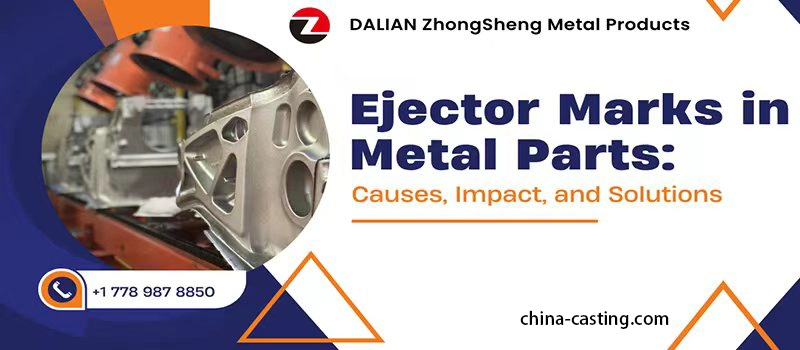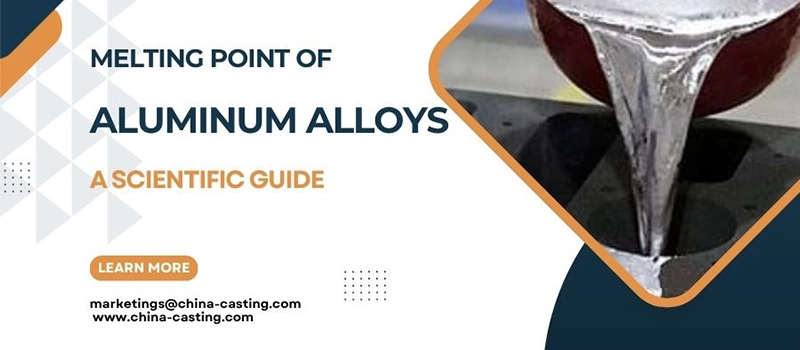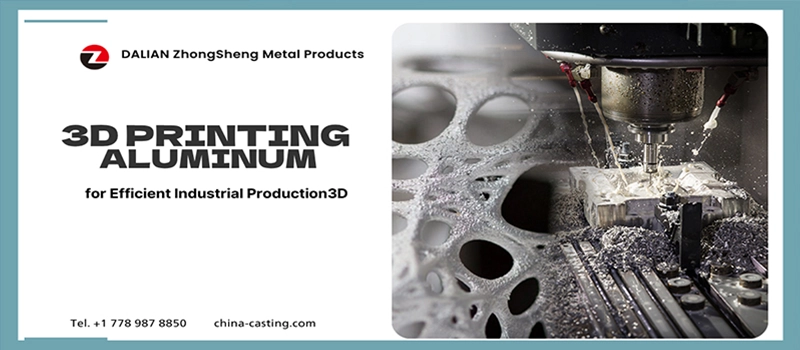Struggling with long lead times in aluminum part production? Losing money on expensive tooling for low-volume or custom orders? Traditional processes like casting and CNC machining often can’t meet the evolving demands for speed, flexibility, and part complexity in today’s industrial manufacturing.
As market pressure increases, manufacturers face tight deadlines, rising costs, and increasingly complex part geometries. Delays, waste, and rigid tooling requirements reduce competitiveness. According to McKinsey & Company,
“Additive manufacturing has the potential to deliver cost savings of up to 30% and time reductions of up to 50% across industries that rely on complex, high-performance components.”
(Source: McKinsey, The State of Additive Manufacturing 2022)
The risk of falling behind is real for companies that rely solely on traditional methods.
3D printing aluminum is a breakthrough solution. It allows for rapid production of lightweight, high-strength parts—without molds or tooling—ideal for prototyping and small-batch manufacturing. Aerospace, automotive, and construction industries are already leveraging its design freedom, speed, and cost efficiency to stay ahead of demand.
What is 3D Printing Aluminum?
3D printing aluminum is becoming a practical option in today’s manufacturing. In our factory, we’ve worked with aluminum for years through casting and machining. Now, we also use 3D printing as a faster and more flexible way to produce parts.
This method builds parts layer by layer from aluminum powder. The powder is melted by a laser and shaped into a solid object based on a 3D design. One of the most common techniques we use is called laser powder bed fusion. It offers high accuracy and makes it possible to create parts with complex shapes.
The biggest advantage is design freedom. We can make hollow parts, internal channels, or lightweight structures that would be hard or impossible with casting or machining. This helps save material, reduce assembly time, and improve performance.
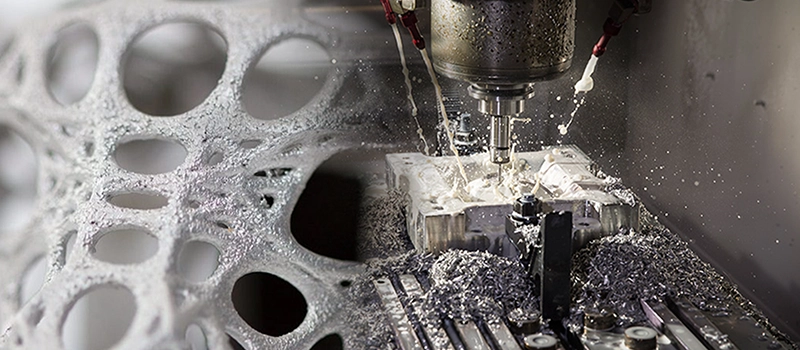
3D printing also shortens the process. We can go straight from design to production without needing molds or tooling. That means faster delivery and lower costs for small runs or custom parts.
It doesn’t replace our traditional methods, but it adds value where speed, detail, and flexibility are needed. For many of our clients, this is exactly what they’re looking for.
Why Use 3D Printing for Aluminum Components?
Faster production without tooling
3D printing aluminum offers a more flexible and time-saving approach compared to traditional manufacturing. Unlike casting or machining, additive manufacturing does not require molds or custom tooling. Once the 3D design is finalized, production can begin immediately.
This leads to shorter lead times and lower startup costs, particularly in low-volume or custom aluminum parts manufacturing. For industrial applications where speed is critical, this process can significantly improve delivery timelines.
Greater design flexibility for complex aluminum parts
One of the main advantages of 3D printing aluminum is the ability to create parts with complex geometries. Traditional methods often struggle with internal channels, fine lattice structures, and weight-reducing features.
Additive manufacturing allows engineers to design aluminum components with:
- Lightweight internal structures
- Thin walls and sharp edges
- Custom surfaces and fine details
These capabilities are especially useful in aerospace, automotive, and high-performance machinery industries, where both structural integrity and reduced weight are essential.
Higher material efficiency and reduced waste
Conventional machining processes remove material from a solid block, generating a significant amount of waste. In contrast, 3D printing aluminum builds parts layer by layer, using only the material necessary to form the structure.
This not only improves raw material utilization but also supports sustainability goals by reducing aluminum waste. In sectors that rely on high-value aluminum alloys, such as energy or precision engineering, the cost savings from material efficiency are substantial.
Shorter development cycles for prototypes
Rapid prototyping is another key benefit of using 3D printing aluminum. Functional prototypes can be produced within a few days, helping engineers test fit, function, and performance early in the development cycle.
This is especially beneficial for:
- Product testing and design validation
- Fast iteration of new concepts
- Reducing time-to-market
In industries where product updates are frequent, such as robotics or industrial automation, this level of speed supports innovation and responsiveness.
Consistent quality and reliable performance
Modern aluminum 3D printing systems offer excellent repeatability. Once print parameters are calibrated, the same aluminum part can be produced multiple times with minimal variation. This level of control is ideal for parts that must meet strict dimensional tolerances and performance requirements.
Although post-processing such as heat treatment or surface finishing is often necessary, the baseline quality of 3D printed aluminum parts is already high. This reduces secondary operations and helps manufacturers meet demanding production standards.
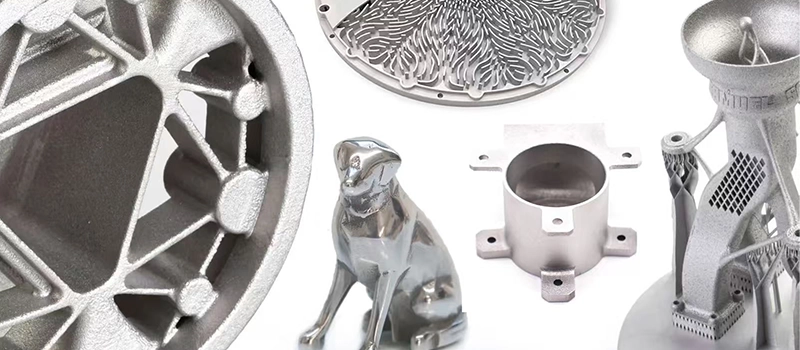
Practical value in modern metal fabrication
3D printing aluminum is not a replacement for casting or CNC machining in every situation. However, for applications that require fast production, complex design, or low-volume output, it offers clear advantages.
Metal fabrication workshops and industrial suppliers are increasingly adopting aluminum additive manufacturing to complement traditional methods. It provides more options for meeting the diverse needs of modern engineering and production environments.
Who Benefits Most from 3D Printed Aluminum?
Industries that rely on lightweight, complex aluminum parts
3D printing aluminum has become especially valuable for industries that require precision, lightweight structures, and complex geometries. Key sectors include aerospace, automotive, robotics, energy, and medical device manufacturing.
In aerospace applications, weight reduction plays a critical role in fuel efficiency and performance. Aluminum parts produced through additive manufacturing can maintain structural strength while minimizing mass. Components such as brackets, housings, ducts, and heat exchangers are increasingly manufactured using 3D printing to meet both performance and design flexibility requirements.
Automotive manufacturers also benefit from custom aluminum components that are lightweight, strong, and optimized for limited-space installations. In motorsports and electric vehicle development, where speed and part optimization are essential, aluminum 3D printing allows rapid iteration and low-volume production.
Machine builders and industrial equipment manufacturers
Companies that build industrial machinery and equipment frequently require custom aluminum parts for tooling, enclosures, and mounting systems. These components often feature complex internal passages, lightweight structures, or non-standard shapes.
3D printing aluminum provides these manufacturers with a solution for producing functional prototypes and end-use parts quickly, without the need for expensive mold fabrication. It is particularly beneficial in high-mix, low-volume environments where design changes are frequent.
Because the process does not rely on tooling, lead times are shorter, and design revisions can be implemented without significant production delays. This supports more efficient project timelines and flexible part customization.
Product designers and mechanical engineers
Designers and engineers working on new product development use aluminum 3D printing to test and validate designs at an early stage. Since the process supports rapid prototyping with functional metals, it enables detailed evaluation of part geometry, structural performance, and assembly fit.
The ability to produce a physical aluminum part directly from a 3D CAD file allows teams to explore more innovative designs, such as lattice structures or consolidated assemblies. These features are often impossible to achieve with traditional subtractive processes or casting.
For many engineering teams, 3D printing aluminum reduces both development cost and time-to-market while maintaining high mechanical performance in test and final parts.
Applications in maintenance, repair, and spare parts production
In industries such as construction, petrochemical, mining, and heavy machinery, downtime due to part failure can result in major financial losses. When replacement parts are obsolete, out of stock, or require long production times, 3D printing aluminum becomes an effective alternative.
Additive manufacturing enables the fast production of custom-fit aluminum spare parts or repair components without the need for inventory storage or complex logistics. The process is especially useful for creating parts that are no longer commercially available or require adaptation to modern systems.
This application supports field-level repairs, equipment upgrades, and operational continuity in environments where time and availability are critical.
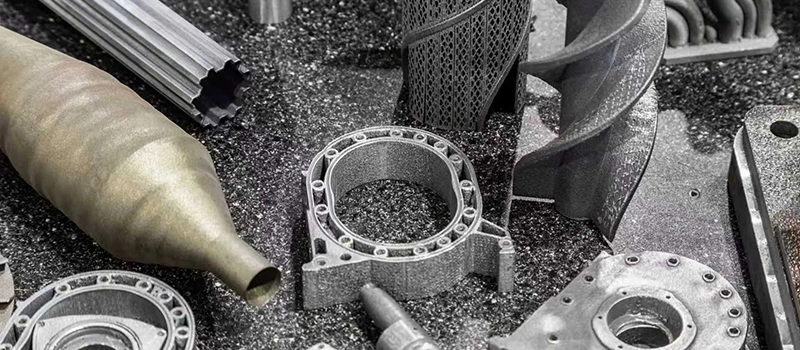
High-value sectors requiring performance and precision
3D printing aluminum offers significant advantages to sectors that value performance, traceability, and mechanical consistency. These include:
- Aerospace and defense
- High-end automotive and motorsport
- Medical instruments and surgical devices
- Renewable energy systems
- Advanced electronics and enclosures
In all of these fields, the ability to create high-strength aluminum components with complex features, without compromising quality, has opened new possibilities in both design and manufacturing strategy.
Where is 3D Printed Aluminum Being Applied Today
Global adoption of aluminum additive manufacturing
3D printing aluminum is rapidly gaining traction across key global manufacturing regions. In markets such as North America, Western Europe, Japan, and South Korea, industrial manufacturers are integrating aluminum additive manufacturing into their production strategies.
These regions have advanced supply chains, high labor costs, and strong demand for custom aluminum components. As a result, companies are investing in 3D printing aluminum to shorten lead times, improve part precision, and reduce dependence on outsourced tooling.
In particular, the demand for aluminum parts produced through additive methods has grown in industries that prioritize lightweight design and fast product development. These include aerospace, automotive, robotics, and energy sectors.
Aerospace and defense applications
In the aerospace sector, 3D printing aluminum is used to manufacture structural brackets, engine components, antenna supports, and lightweight housings. Aluminum’s excellent strength-to-weight ratio makes it ideal for aircraft design, where even minor weight savings contribute to fuel efficiency.
Additive manufacturing allows for aluminum parts to be redesigned with internal channels, integrated mounting features, or lattice geometries—all of which reduce part count and assembly time. For both commercial aviation and defense contractors, this means faster development, easier part customization, and simplified logistics.
Several major aerospace companies are already scaling production with aluminum 3D printing. The process supports both prototyping and low-volume production runs, offering supply chain flexibility and consistent part quality.
Automotive and motorsport innovation
In the automotive industry, 3D printing aluminum is used to create high-performance engine parts, suspension brackets, transmission housings, and structural supports. These aluminum components often feature complex shapes that would be difficult or expensive to produce using casting or machining.
Electric vehicle manufacturers and motorsport teams benefit from custom aluminum parts with reduced weight and improved heat dissipation. Aluminum additive manufacturing also enables quick adaptation of designs during vehicle development and testing phases.
Need Help? We’re Here for You!
Because automotive production often demands tight tolerances and consistent part strength, aluminum 3D printing is well suited to small-batch runs, experimental builds, and specialized product lines.
Construction, energy, and industrial machinery
3D printed aluminum is increasingly used in the construction and energy industries for producing durable yet lightweight parts. Common applications include:
- Custom aluminum enclosures for electrical systems
- Lightweight heat sinks for energy storage and conversion equipment
- Mounting systems for solar panels or wind turbines
- Structural connectors in architectural assemblies
Industrial machinery manufacturers are also leveraging aluminum additive manufacturing to create machine housings, ergonomic handles, custom fixtures, and cooling channels. These parts require precision, corrosion resistance, and often need to be delivered within short timeframes.
By using 3D printing aluminum, manufacturers can produce functional components on demand without maintaining large inventories or relying on traditional suppliers.

Medical devices and specialized equipment
In the medical field, 3D printing aluminum is applied to develop strong, sterilizable parts for surgical tools, imaging systems, and mobility equipment. These aluminum components must meet strict dimensional accuracy and surface finish requirements.
The ability to create complex geometries and reduce part weight makes aluminum additive manufacturing ideal for producing functional, ergonomic devices that improve usability and safety.
Hospitals and medical equipment manufacturers are adopting this technology for rapid development, quick turnaround for prototypes, and the production of small batches tailored to specific patient or equipment needs.
Emerging applications in electronics and consumer products
Beyond heavy industry, aluminum 3D printing is being used in consumer electronics and luxury products. Applications include:
- Lightweight aluminum cases for laptops and drones
- Cooling elements for LED and power electronics
- Custom aluminum frames for bicycles and sporting goods
- Decorative metal components with unique surface designs
These use cases reflect how aluminum additive manufacturing is expanding beyond traditional sectors into design-driven markets. With the right finishing processes, 3D printed aluminum parts can meet both functional and aesthetic requirements.
When is 3D Printing Aluminum the Right Choice?
Ideal conditions for using 3D printing aluminum
3D printing aluminum is most effective in industrial scenarios where speed, precision, and customization are critical. Unlike casting or CNC machining, aluminum additive manufacturing allows for the direct production of aluminum parts from a digital model, without molds or special tooling.
This makes it especially valuable in time-sensitive projects, small-batch production, and applications that require complex internal geometries. Companies that need custom aluminum components with specific mechanical requirements and fast delivery benefit the most from this technology.
When compared to traditional manufacturing methods, 3D printing aluminum significantly reduces setup time, eliminates tooling costs, and simplifies design revisions. This gives manufacturers a clear advantage during early product development, low-volume production runs, or when responding to urgent repair needs.
When short lead time is a priority
One of the main reasons manufacturers choose 3D printing aluminum is the ability to produce aluminum parts quickly. In industries where time-to-market directly affects competitiveness, the speed of aluminum additive manufacturing provides a strategic benefit.
Because there is no waiting time for molds, fixtures, or cutting programs, the production of aluminum parts can begin as soon as the design is finalized. In many cases, lead times are shortened from several weeks to just a few days. This allows manufacturers to meet urgent client demands, reduce downtime, and improve response times across the supply chain.
3D printing aluminum is therefore ideal for rapid prototyping, fast part replacement, or development cycles where time pressure is high.
When part complexity makes traditional methods impractical
Certain aluminum parts are difficult or impossible to produce using conventional processes. For example, internal cooling channels, thin-wall hollow sections, and multi-functional integrated structures can be manufactured efficiently through 3D printing aluminum.
Aluminum additive manufacturing enables engineers to design parts based on function, rather than process limitations. The ability to print complex shapes in a single build reduces assembly steps, enhances performance, and lowers the risk of failure at connection points.
This makes 3D printing aluminum the preferred choice when part design requires high complexity, reduced mass, and multi-feature integration—common in aerospace, electric vehicles, and energy equipment.

When production volume is low or highly customized
For low-volume production, 3D printing aluminum provides significant cost advantages. Traditional manufacturing becomes expensive when used for just a few units due to the high cost of tooling and setup. In contrast, aluminum additive manufacturing is scalable from a single unit to small batches, with no tooling investment required.
This is especially useful for producing custom aluminum components, spare parts, jigs, fixtures, and unique machine elements. Engineering teams and manufacturers can experiment with design changes without financial risk, as each iteration can be printed directly with minimal delay.
In high-mix, low-volume environments—such as specialty equipment production, industrial machine retrofitting, or localized manufacturing—3D printing aluminum is often the only viable solution.
When weight reduction is a core design goal
Aluminum is already known for its excellent strength-to-weight ratio, and when combined with 3D printing, even greater weight reduction can be achieved. Engineers can use aluminum additive manufacturing to create optimized lattice structures, remove non-critical material, and merge multiple parts into a single lightweight unit.
This is ideal for aerospace brackets, automotive housings, and robotic arms where every gram matters. The result is lighter aluminum parts that still meet structural performance requirements.
3D printing aluminum therefore supports design strategies focused on fuel efficiency, payload optimization, and ergonomic improvements.
When conventional supply chains cannot deliver
In today’s manufacturing environment, global supply chain delays are common. When casting suppliers are backlogged, or CNC capacity is limited, 3D printing aluminum becomes a reliable in-house or local option to fill the gap.
Manufacturers that integrate aluminum additive manufacturing into their production lines can reduce dependence on external suppliers. They also gain greater control over production timelines and quality assurance for custom aluminum parts.
This is especially important in sectors like mining, construction, and energy where unexpected equipment failures require fast, on-site part replacement—and every day of delay has financial consequences.
Conclusion
3D printing aluminum is becoming a practical and strategic tool in modern industrial manufacturing. Its advantages—such as fast production, design flexibility, material efficiency, and support for custom aluminum parts—make it ideal for industries with strict requirements and short timelines.
While not a full replacement for traditional methods like casting or machining, aluminum additive manufacturing offers unique value in specific applications where complexity, speed, and low-volume production are critical.
As the technology matures and equipment becomes more accessible, more manufacturers are integrating 3D printing aluminum into their production workflows. It complements existing metal fabrication processes and provides new opportunities for innovation, cost control, and competitive advantage in industrial environments.


